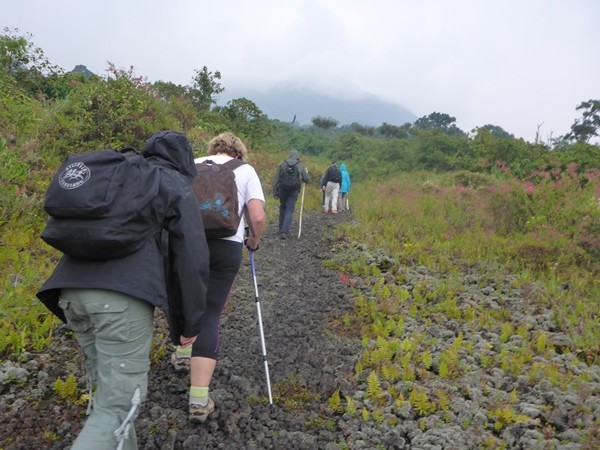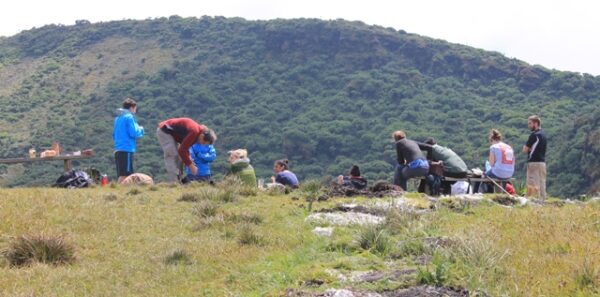
How To Hike Mount Bisoke Effectively
How To Hike Mount Bisoke Effectively : The most well-liked location for mountain trekking excursions in Rwanda is Mount Bisoke (3711m). The mountain is a component of the Volcanoes National Park, Rwanda’s most visited park and home to the country’s golden monkeys and mountain gorillas. The park is made up of five volcanoes.
Everyone who hikes the Bisoke volcano looks forward to the enormous, gorgeous Crater Lake at the summit as the ultimate reward. Since Mt. Bisoke is home to numerous gorilla families, the hike there also provides a decent possibility of spotting gorillas. In the lower elevations of the mountains where they reside, one can frequently spot the stunning golden monkeys at the beginning of the walk or during the last descent. Continue reading this article to get to know more on how to hike mount Bisoke effectively.
Even for seasoned hikers, the Mount Bisoke journey can be a strenuous hike as it demands participants to ascend the peak and descend in a single day. The goal is to trek to the top of the volcano in no more than six hours, but you’ll need to be alert for sudden weather changes there, as clouds can suddenly gather and cause a hailstorm. At the summit, the weather is subject to fluctuate during the day, with afternoon showers being particularly likely. As a result, you have to be on your feet all the time, with little time for rest, until you reach the summit before the weather changes. The more time you have to enjoy a picnic at the stunning Crater Lake while the weather is still nice, the earlier you reach the peak. Many who do not think the walk will be difficult give up in the first half hour and head back to base.
On the other hand, you can enjoy the walk up Mount Bisoke and reach the peak with enough planning and preparation.

How to prepare for the Mount Bisoke trek?
Fitness.
A fit body is essential for the Mount Bisoke trip. Your muscles’ energy levels are impacted by a decrease in oxygen levels as you ascend the mountain. You will have more endurance with less oxygen the fitter you are.
Therefore, especially for inexperienced hikers, start running and working out a few weeks before your excursion. To increase your leg strength and endurance, choose the tallest points in your neighborhood and practice walking or running in the shortest amount of time.
Acclimatization – sleep in Ruhengeri near the park.
Aside from physical fitness, the shift in height will have the most impact on your trek (you can call it altitude sickness). There is less oxygen in the atmosphere the higher you go. If you are accustomed to living at low or high altitudes, your body is accustomed to requiring a lot of oxygen. Because of this, your body will tyre out faster as you ascend (compared to someone from a high altitude place).
You should choose to spend a day or several days in the Ruhengeri district close to the mountains prior to your walk in order to allow your body to adjust to lower oxygen levels. The region is situated at an elevation of over two thousand metres above sea level. In addition to being in good shape, your body may not adjust rapidly, but it will still aid in some way.
Hiking Mount Bisoke is best done in the dry season as opposed to the wet season.
The difficulty of your walk will also depend on the season you choose to climb Mountain Bisoke. There are two seasons in Rwanda: the dry season and the rainy season. There is a brief dry spell in December and January, followed by a protracted dry season that runs from June to mid-September. Subsequently, there is the extended wet season spanning from March to May, as well as a brief period from October to November.
The dry season, when the trail is clear of muck, is undoubtedly the easier time to walk. Though it is never as harsh as the rainy season, keep in mind that the mountains sometimes occasionally receive rain during the dry season, so you should still be prepared.
Essential items to carry for the Bisoke trek
The following are essential for the trek.
- For the trek, good-traction hiking shoes are a must. There is no getting around the fact that you must walk during the rainy or wet season.
- Long outdoor trousers to shield legs from bug bites and scratches.
- Long sleeves to prevent scrapes on the hands.
- An umbrella, jacket, or poncho.
- Gardening mitts.
- Cap or hat.
- Sunscreen.
To take a porter or not to take one.
For $10, you may hire a porter to carry everything you need carried, including your backpack. Many hikers don’t want to part with the $10 since they believe they can manage their modest bags. Nevertheless, even the watch on your wrist will feel like a pound tethered to your hand after a half-hour hike up the mountain. Therefore, even if you feel capable, it is recommended that you employ a porter. When things get hard, the porter will not only carry your backpack but also give you a shove or pull.
Hiring a porter also benefits the local community that surrounds the gorillas directly. Porters are locals and some of them have experience with poaching; this is one method of deterring them from doing it in the future.
Do not forget to take snacks for the trek.
Travellers frequently make the mistake of leaving behind water and a food for the walk. Your stomach may be empty by the time you reach the summit due to the exhausting nature of the trek. Before you descend, you will eat a snack and “recharge” at the summit.
In summary, the above article entails all you need to know on how to hike mount Bisoke effectively.


